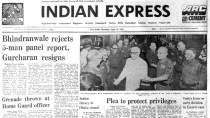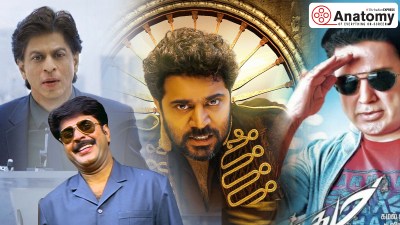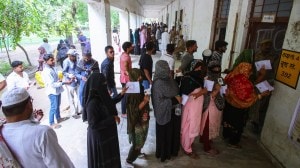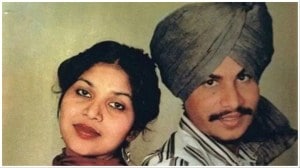- India
- International
Speaking easy
Why most Indians are likely to shrug off government attempts to impose Hindi.
 Prime Minister Narendra Modi. (Source: PTI)
Prime Minister Narendra Modi. (Source: PTI)
What is the Hindi for “yenna rascalla”, the battle cry of enraged 20th century Tamil gentlemen? How does one translate “aapke muh mein ghee-shakkar”, which Narendra Modi turned sarcastically upon Sonia Gandhi during the election campaign, and which sounds literally unpalatable outside the Hindi belt? Such linguistic specificities help to explain why language issues reach smoke point so rapidly in India: our identities are natively rooted in speech. Last week, tempers rose over a notification prescribing the use of Hindi in the government’s social media communications and offering laughably tiny cash incentives for using the language in official business. Flashpoint was averted by the discovery that this was only a UPA notification warmed over.
So the ham-fisted promotion of Hindi is just another bad habit inherited by the NDA from the UPA, along with nebulous anxieties about NGOs and foreign money, but the issue singed the government. Very rarely does a procedural notification cause national irritation, from Urdu-speaking Kashmir to Tamil-proud Kanyakumari. Even the NDA’s allies, present and potential, were incensed.
The language issue is older than the Union of India. In the 1920s, the Congress had resolved to pursue the linguistic reorganisation of states, to strengthen language identity at the expense of violence-prone markers like caste, community and religion. Linguistic demarcation was written into law in the States Reorganisation Act of 1956 but sadly, unhealthy identity markers continued to flourish.
Rootedness in language is not exclusively an Indian phenomenon but possibly a subcontinental feature. We identify the language wars with Dravidian politics, but neighbouring Bangladesh offers a different scale altogether. It owes nationhood to a language movement opposing the imposition of Urdu by West Pakistan. The killing of students in Dhaka University on February 21, 1952, is commemorated as Bhasha Andolan Dibas.
It is the most important national holiday since the spark lit by the movement burst into flame 19 years later in the Liberation War, which redrew the map of South Asia and reordered the relationship between India and Pakistan. In recognition of the profound historical and geopolitical influence of the movement, the UN celebrates February 21 as International Mother Language Day.

In South Asia, trying to valorise one language over another is always a fraught experiment, and the results of imposing a language can be catastrophic. Or ridiculous, which is worse. The organised state promotion of Hindi began in the Indira Gandhi era, with the establishment of the Department of Official Language in the home ministry in the 1970s. Its most palpable impact was the development of a shamelessly pseudo-Sanskritic pidgin, which actually consisted of back-constructions from English.
The phrase “kaam pragati par hai” is an exact replica of “work in progress” but sounded meaningless and peculiar when it was coined. India names its daughters Pragati but significantly, no British or American women are named Progress. “Bhoomigat paidal paar path” replicates “pedestrian underpass” but to a native Hindi speaker, it sounds like machine-generated garbage that escaped the spam filter. Mrs Gandhi’s synthetic garbage language is still visible on public signage and, at the time, was piped into homes via state television. Fortunately, people generally shrugged it off as yet another elaborate joke at public expense.
To return to the present notification promoting the use of Hindi, Tamil Nadu’s political establishment has risen in high umbrage across party lines, but what about the Indian people? Are they as fearful of the loss of their regional cultures as they were in Mrs Gandhi’s time? Then, the linguistically defined identities marked by state borders were palpable. You knew precisely when your train crossed an invisible state border. Everything changed — the advertisements, signage, architecture, people’s clothes, the music on the radio. Now cable TV, the internet and cinema have flattened the cultural sphere a bit, and acclimatised people to Hindi too.
Back in the 20th century, Delhi used to worry about a basic question: could infinitely varied India ever have a national culture? Dhanush, among others, has now given us the answer: yes, sort of. His soup song, which was actually a movie promo, was ramped up by cable and the internet. This national culture is not based on language. Rather, it trivialises it. It communicates by lampooning communication, as in the popular Western cartoon shows on TV, dubbed in Mumbai tapori. It embarrasses itself in formal speech. Haven’t you ever been in a flight where the cabin crew was inarticulate in three languages?
Would the citizenry of such a national culture put their lives on the line for linguistic identity, like they once did in Tamil Nadu and Bangladesh? Kiren Rijiju, whose native Arunachal Pradesh isn’t exactly in the Hindi heartland, and who finds himself in the unusual position of having to defend Hindi as minister of state for home, should consider this question before his Department of Official Language shoots off another notification. And, if only to savour the delightful bizarreness of the language issue, he could also ask himself: what is the Monpa for, “Mind it, rascalla!”
pratik.kanjilal@expressindia.com
EXPRESS OPINION
More Explained
Apr 26: Latest News
- 01
- 02
- 03
- 04
- 05











































